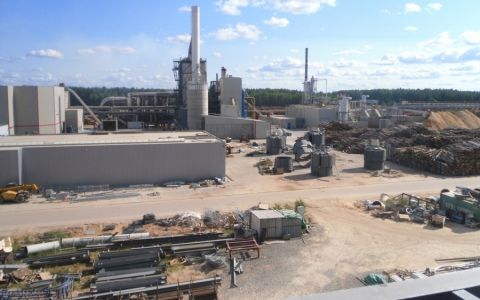Ostrovec nuclear power plant is being constructed about 18 km from Ostrovec town in Grodno region. Consisting of two 1,200MW units the 2,400MW NPP is to be the first of its kind in the county. The project is being overseen by the state enterprise Directorate for Nuclear Power Plant Construction under the Ministry of Energy, who will also be the operator. The project was conceptualized in 2007. The first concrete was poured in November 2013 and the first unit is scheduled for commissioning in November 2019, followed by the second unit in July 2020. Two other reactors are planned to be completed by 2025.
The initial plans to build a nuclear power plant were announced already in the 1980s, but were suspended after the 1986 Chernobyl disaster. The drive for the current project was fueled by the Russia-Belarus energy dispute in 2007. Belarus, which imports about 90 percent of its gas from Russia, is forcing the project in the hope that it will free itself from its dominant neighbor. Nonetheless, Moscow is jointly financing the project, which is estimated to cost between 5 billion to 22 billion of US dollars and the plant is being built by Russian company “Rosaatom”, known as company with high risk of corruption and insecurity.
Construction raising safety concerns
Belarusian nuclear power plant near Ostrovets, in about 20 km from Lithuanian border and 50 km from its capital Vilnius, raised a lot of concerns by public and experts. The project is followed by multiple accusations for failing to conform with international environmental standards, such as set by united nations Aarhus and Espoo conventions, as well as to provide response on inquiries submitted by its nearest neighbour Lithuania on the safety and security of the project. According to Lithuania the Belarusian government had chosen the site for the plant without properly assessing its suitability or exploring alternative options, and failed to study the plant's future environmental impact. It stresses that the area was hit by a 5-7 magnitude earthquake in the past and that a possible accident at the plant could contaminate 95 percent of the drinking water consumed by a third of Lithuania's population.
In July 2016 was reported by local news that a nuclear reactor shell had been dropped while being moved. The 330-tonne shell had fallen from a height of 2-4m in preparation for installation. Two weeks later the Belarusian Energy Ministry confirmed that an “emergency situation” had occurred at the construction site. The reactor had been replaced later, but the incident clearly demonstrated the lack of transparency and the reluctance of Belarus government to take responsibility.
It was not the first accident at the construction site, nor the first time Belarusian officials have resisted divulging any details. The structural frame of the nuclear service building at the site collapsed in April 2016, as first reported by the Belsat independent TV station. According to the report, supervisors, under pressure to meet a deadline, ordered workers to pour to much concrete causing the structure to collapse. No mention of the accident was made in the Belarusian state media or by officials, with the spokesman at the plant first denying anything had happened. In May, the Belarusian energy ministry however, did confirm an “incident” had occurred during the pouring of concrete.
Civic society against the construction
Since 1986 activists and NGOs in Belarus had been making efforts to raise awareness of the citizens about nuclear power effects on the environment and human health. Belarus territory was heavily affected by the Chernobyl accident. About 23 per cent of the Belarus territory was contaminated and the accident negatively affected millions of people. Since late 2000´s these efforts aimed at actions to ensure that the public in Belarus is aware of possible implications of the nuclear power plant construction in Belarus.
In 2008, a civil society group in the Horki district, Mahilyow region, has collected more than 2,500 signatures to a petition against the planned construction of a nuclear power plant in Belarus. While collecting signatures, campaigners inform local residents about the possible consequences of the construction of a nuclear power plant for them and the environment, he noted. Other protests concerned the Russia’s involvement in construction of Belarusian nuclear power plant and the lack of political debate on the matter.
Harassment of anti-nuclear activists
As soon as the Government of Belarus took a decision to plan construction of the nuclear power plant in Ostrovets, the activists and NGOs opposing such plans were subject to harassment and persecution. This was done in form of detentions, arrests, bans on entering the country, searches, and seize of leaflets.
Citizen’s prefer job opportunities to environmental thread
Whereas the research for the public opinion in neighboring countries is still in process, the majority of the population in Belarus (55.7 %) believe that with the launch of the nuclear power plant the situation in the energy industry will improve. As for the social groups, the biggest support for the NPP project is seen among entrepreneurs, company managers, rural dwellers, blue collars and students[1].
However when constructed, the plant is supposed to supply only some 15 percent of the country’s electricity needs and the negative effects prevail.
The controversial construction is still ongoing despite the critics of local environmental groups and international community.
[1] Source: http://eng.belta.by/society/view/number-of-nuclear-energy-supporters-growing-in-belarus-99144-2017
More information:
A website dedicated to persecution of environmental activists: www.nopersecustion.org
Facebook page of the Belarus Antinuclear Campaign: https://www.facebook.com/antinuclear.belarus/
Ostrovec nucler plant – we are against (Russian only)






